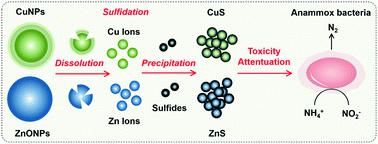当前位置:
X-MOL 学术
›
Environ. Sci.: Nano
›
论文详情
Our official English website, www.x-mol.net, welcomes your feedback! (Note: you will need to create a separate account there.)
Sulfidation attenuates the adverse impacts of metallic nanoparticles on anammox from the perspective of chronic exposure
Environmental Science: Nano ( IF 7.3 ) Pub Date : 2020-04-27 , DOI: 10.1039/d0en00219d Zheng-Zhe Zhang 1, 2, 3, 4, 5 , Yu Zhang 5, 6, 7, 8, 9 , Ya-Fei Cheng 1, 2, 3, 4, 5 , Ren-Cun Jin 1, 2, 3, 4, 5
Environmental Science: Nano ( IF 7.3 ) Pub Date : 2020-04-27 , DOI: 10.1039/d0en00219d Zheng-Zhe Zhang 1, 2, 3, 4, 5 , Yu Zhang 5, 6, 7, 8, 9 , Ya-Fei Cheng 1, 2, 3, 4, 5 , Ren-Cun Jin 1, 2, 3, 4, 5
Affiliation

|
The risks of metallic nanoparticles (MNPs) in anammox have attracted increasing attention; however, how sulfidation, an important environmental transformation process, affects their toxicity potential is unclear. The chronic responses of anammox biomass to exposure to pristine and sulfurized MNPs were compared in this study. Exposure to 2.5 mg L−1 CuNPs and 2.5 mg L−1 ZnONPs resulted in an almost 99% decrease in nitrogen removal capacity within 55 days; however, 68% of the nitrogen removal capacity could be maintained with the aid of sulfidation. The inhibition on the transcription and enzyme activity of hydrazine dehydrogenase was attenuated by reducing the metal content of the anammox biomass, which induced higher specific anammox activity at the metabolic level and higher abundance of anammox bacteria at the community level over time. Therefore, these results highlight the need to consider environmental transformations of MNPs to accurately evaluate their potential environmental risks.
中文翻译:

从长期暴露的角度看,硫化可减轻金属纳米颗粒对厌氧氨氧化的不利影响
厌氧氨氧化金属纳米颗粒(MNP)的风险已引起越来越多的关注。然而,尚不清楚硫化是重要的环境转化过程如何影响其毒性潜能。在这项研究中,比较了厌氧氨氧化生物质对暴露于原始和硫化MNP的慢性反应。暴露于2.5 mg L -1 CuNPs和2.5 mg L -1ZnONP导致55天内脱氮能力降低了近99%;然而,借助于硫化可以保持68%的脱氮能力。随着时间的推移,通过降低厌氧氨氧化生物量的金属含量,减弱了对肼脱氢酶的转录和酶活性的抑制,这在代谢水平上诱导了更高的厌氧氨氧化比活,并在社区层面上引起了更高的厌氧菌丰度。因此,这些结果强调需要考虑MNP的环境转化,以准确评估其潜在的环境风险。
更新日期:2020-06-18
中文翻译:

从长期暴露的角度看,硫化可减轻金属纳米颗粒对厌氧氨氧化的不利影响
厌氧氨氧化金属纳米颗粒(MNP)的风险已引起越来越多的关注。然而,尚不清楚硫化是重要的环境转化过程如何影响其毒性潜能。在这项研究中,比较了厌氧氨氧化生物质对暴露于原始和硫化MNP的慢性反应。暴露于2.5 mg L -1 CuNPs和2.5 mg L -1ZnONP导致55天内脱氮能力降低了近99%;然而,借助于硫化可以保持68%的脱氮能力。随着时间的推移,通过降低厌氧氨氧化生物量的金属含量,减弱了对肼脱氢酶的转录和酶活性的抑制,这在代谢水平上诱导了更高的厌氧氨氧化比活,并在社区层面上引起了更高的厌氧菌丰度。因此,这些结果强调需要考虑MNP的环境转化,以准确评估其潜在的环境风险。



























 京公网安备 11010802027423号
京公网安备 11010802027423号